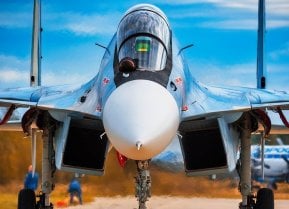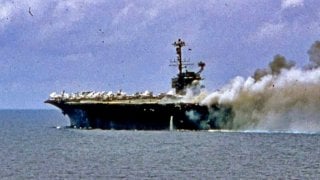USS Forrestal: How A Navy Aircraft Carrier Was Nearly Destroyed by Fire
On July 29, 1967, the USS Forrestal suffered a huge fire on her flight deck, resulting in the loss of more than 130 men and numerous aircraft.
The USS Forrestal Fire, Explained: Aircraft carriers can be dangerous places to work. These ships are literally floating airports, and if proper safety measures aren't carried out, things can turn deadly. In the 1960s, the U.S. Navy learned several lessons after it had suffered a series of deadly accidents aboard its carries.
Many of the incidents came about due to the inherent dangers of operating ships that were packed full of explosive munitions, jet fuel, and aircraft. Thankfully, those accidents resulted in major reforms that better handled how the crews operated and how they responded to such a crisis in the future. Of course, those changes were little comfort to the families of those killed.
That is certainly true of the families of the 134 who were killed aboard the USS Forrestal (CV-59) in July 1967, while another 161 were injured.
USS Forrestal had been the U.S. Navy's first "supercarrier" and was the largest ever built when she was commissioned in 1955. The carrier would also suffer the largest fire on a U.S. warship since World War II.
The USS Forrestal in the Spotlight
Although the Forrestal-class is now closely associated with the Cold War era, its development actually began during the Second World War, when the United States Navy admiralty began to think beyond the Midway-class that only entered service just as the hostilities ended. In addition to seeing the need for an armored flight deck for added survivability, the admiralty also determined that the next class of carriers would need to be far larger, and, more importantly, able to accommodate larger jet aircraft.
Commissioned on October 1, 1955, at Newport News, Virginia, as the U.S. Navy’s first supercarrier, CVA-59 — "attack aircraft carrier" and later just redesignated as CV-59 — initially operated in the Atlantic and the Mediterranean, where she provided support during the Lebanon crisis in 1958.
The Forrestal subsequently was deployed numerous times to the Mediterranean until 1966 when she received an overhaul. She was ordered to the Pacific during the Vietnam War to provide additional airpower, and it was during that deployment that tragedy struck.
On July 29, 1967, USS Forrestal suffered a huge fire on her flight deck, resulting in the loss of more than 130 men and numerous aircraft.
Fire on the Flattop
The incident aboard the USS Forrestal also occurred just nine months after a devastating fire broke out on the USS Oriskany, which resulted in the loss of forty-four sailors and pilots. The cause of the fire was tragically simple; a mishandled flare triggered rockets stored in an ammunition locker.

The three-foot-long flare, burning at 5400 degrees Fahrenheit, set off the roughly 700 other flares inside the locker. The resulting explosion blew out the steel bulkheads of the flare locker, instantly killing five sailors, while two nearby helicopters caught fire. Flaming debris spread into the forward berthing areas. Smoke and flames quickly spread into passageways and ventilation systems, trapping dozens of officers in their staterooms.
The air wing lost two UH-2A helicopters and a Douglas A-1 Skyraider destroyed, with another three A-4s damaged, while the ship itself suffered heavy fire damage.
In the case of the fire on the USS Forrestal, it began with the accidental launch of a rocket while the carrier was stationed off the coast of North Vietnam conducting combat operations. On the morning of July 29, 1967, the warship was preparing to launch its fighters when a rocket from an F-4 Phantom jet was accidentally launched and hit a parked A-4 Skyhawk jet waiting to take off.

That particular Skyhawk was piloted by future Senator John McCain (R-Arizona).
Fuel from McCain's Skyhawk spilled out and caught fire, which spread quickly to nearby planes on the ship's flight deck and detonated a 1,000-pound bomb. That explosion tragically killed many of the initial firefighters and further allowed the fire to grow – until a chain of explosions blew holes in the flight deck.
Several pilots were trapped in their planes, and sailors had to manually jettison the numerous 250 and 500-pound bombs by literally rolling them along the deck and over the side. Moreover, many sailors who had little-to-no firefighting and damage control training took over from those killed in the explosions.
However, the inexperienced hose teams employed saltwater, which only washed away other efforts to douse the flames with foam.
In the end, it took a full day before the fire on USS Forrestal was fully contained. It was the worst loss of life on a U.S. Navy ship since the Second World War. In addition to the 134 sailors and airmen who were killed, twenty planes were destroyed.
Costly Lesson Learned
The ship underwent temporary repairs at Subic Bay in the Philippines and then headed back to Norfolk. Repairs cost about $72 million (more than $601 million in 2022 dollars), while some 175 feet of the aft flight deck was removed and replaced along with about 200 compartments on six decks.
The carrier was fully repaired by April 1968, yet the warship never returned to Vietnam. The disaster also prompted the U.S. Navy to revise and improve its firefighting practices and also to modify the procedures for handling weapons.
USS Forrestal became informally known as the "USS Zippo" and "Forest Fire" after being repaired, and she remained in service until 1993. While the aircraft carrier was made available to become a museum ship, those attempts were unsuccessful, and she was scrapped in Brownsville, Texas in 2014.
John McCain survived the fire, volunteered for duty on the USS Oriskany, and was shot down just three months later and was taken prisoner by the North Vietnamese. He was not released until five and a half years later. He later served two terms in the United States House of Representatives and served as the United States Senator from Arizona from 1987 until his death in 2018.
Author Experience and Expertise
Peter Suciu is a Michigan-based writer. He has contributed to more than four dozen magazines, newspapers, and websites with over 3,200 published pieces over a twenty-year career in journalism. He regularly writes about military hardware, firearms history, cybersecurity, politics, and international affairs. Peter is also a Contributing Writer for Forbes and Clearance Jobs. You can follow him on Twitter: @PeterSuciu.
All images are Creative Commons.


